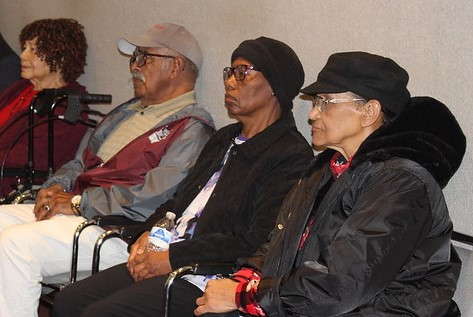Desegregation pioneer reflects on experience

Pictured from left are Scarboro 85 students Alma Stevens, L.C. Gipson and Emma McCaskill. They were in the audience at the Dec. 9 Oak Ridge City Council meeting, during which the council honored them with a resolution. Joining them was the Rev. Margaret Mack, assistant pastor at Oak Valley Baptist Church.
Oak Ridge resident L.C. Gipson was one of a group of 85 students, now known as the Scarboro 85, for the segregated Black neighborhood from which they came before making Civil Rights history.
The group entered the formerly all-white Oak Ridge High and Robertsville Middle schools Sept. 6, 1955. It was a year after the Supreme Court’s Brown vs. Board of Education ruling required integration.
Neighboring Clinton desegregated its school system in 1956 with the Clinton 12. Oak Ridge Schools, however, were under the control of the U.S. Atomic Energy Commission at the time, making their desegregation different from other public schools. Unlike Clinton, where the desegregation was met with violent mobs and bombings, Oak Ridge avoided such incidents.
Still, the AEC’s decision to begin integrating schools in 1955 led the start of integrated schools for Oak Ridge and the Southeast.
Gipson recently reflected on the history he lived. He said he grew up in Mississippi. He declined to name the town, but he said it did not matter when it came to racism.
“The same playbook; just a different town, different state, the same dang playbook,” he said regarding towns in the South at that time.
“Anyone of different color from you, you had to be very careful of how you interacted with that person,” he said. “You could end up being an Emmet Till. So that’s what I brought to Oak Ridge High School. That background.”
He was referring to the murder of Emmet Till, which happened Aug. 28, 1955, less than a month before Gipson started at ORHS.
Oak Ridge’s businesses were also segregated in the 1950s. Gipson said he remembered Black people having to pick up food at restaurant windows rather than sit down inside.
Gipson started out at Oak Ridge’s Black school, called Scarboro School, which used older textbooks than the white school. Still, he spoke of it fondly.
“Teachers were invested in every one of us,” he said regarding Scarboro School. “It was like a family affair. They wanted us there.”
By contrast, he said he didn’t feel wanted by his teachers at the mostly white ORHS.
“Any time you are in an environment, and you know that the teacher or professor doesn’t want you there, does it make it harder for you? Heck yeah!” he said. He also said he lacked any study partners who lived in his community, making coursework difficult.
“As night and day,” he said regarding the difference between 1950s and modern Oak Ridge. However, he said hatred is still present in society.
“Now they don’t want history to be taught in schools,” he said. “So, they ignore what I did. What my classmates did. What we had to encounter back in the day. They don’t want that taught. That’s sad.”
Still, he said he felt encouraged by the plan to build a monument to the Scarboro 85 in A.K. Bissell Park.
“I’m so glad they’re doing it; I hope they get done before I die off and the rest of my classmates die off,” Gipson said, pointing out that out of the 85, only about half are still living.

